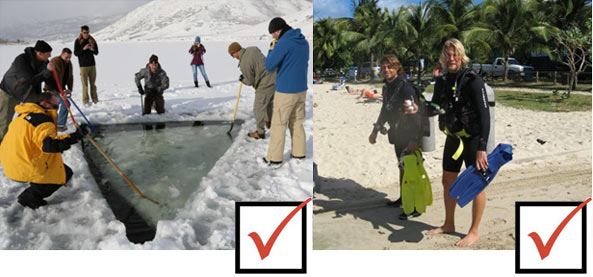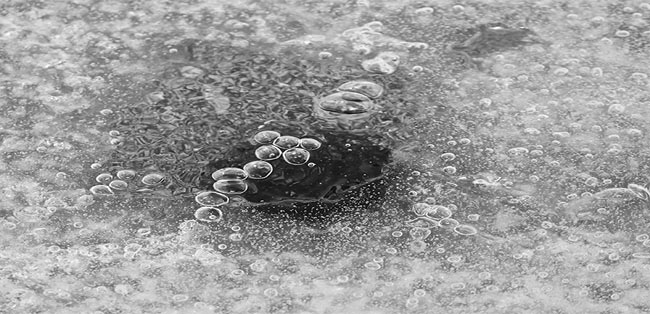Ice
Diving – The bare facts
Posted
on: February 18, 2014
NOTE: While the events
portrayed in this article are true, the names have been withheld to protect the
semi-guilty!
by Jeffrey Bozanic,
TDI 33
I had been down on the
Ice for 3 months. That already seemed like a long time, and a few of my already
loose screws were getting even looser. But I was in good company. After a
couple of months, everyone starts going a little stir crazy.
Oh… “the Ice” means
Antarctica. I was there serving as the Dive Locker Technician, and about
halfway through my second season there. My duties were to keep equipment
operational for the scientists diving there, check out the new incoming
scientific divers and orient them to dive operations in the U.S. Antarctic
Program, and participate in scientific dives as needed. I also was allowed to
conduct some of my own [legitimate] research. This experience did not
qualify…ouch!
At the time a good
friend of mine had been a long time diving instructor in
the Caribbean. He had also done several saturation dives in the
Hydrolab, the NOAA owned underwater habitat managed by The West
Indies Laboratory of Fairleigh Dickenson University stationed in St. Croix,
U.S. Virgin Islands. It was an underwater habitat, where scientists would
saturate for week-long periods, spending hours conducting research in the 82oF
(28C) water surrounding the habitat. A somewhat more hospitable environment to
oversee dive operations than the 28.6oF (-2C) water and average -20oF (-29C)
air temperatures in which I was working. I had previously asked my
friend to join me on a planned Antarctic saturation mission.
He had replied something to the effect of, “Are you #^$&ing crazy?
It’s too damn cold there!”
Knowing how isolated
it was down on the Ice (these were the days before the station had ample data
bandwidth for telephone calls, Internet access, or other communication) he
decided to help out by sending me a cheerful photograph of him diving the warm
waters of the Caribbean. Naked. With two gorgeous women equally attired, one in
each arm. On the back he had inscribed one piece of advice for me… “Eat your
heart out, Bozanic!” (I’d send the photograph, but this is not that kind of
website!).
Oh, what are friends
for??
I could not let him
get away unscathed. So I decided I would one-up him, sending him a picture of
me under the ice… also naked.
My friend “Diver X”
and I planned the dive carefully. We would conduct the scientific dive and
complete the objectives we needed to for the day. Then I would climb out and
get out of my dry suit, while he waited for me on the surface. When I was
ready, he would descend down the hole, below the seven foot thick sea ice, and
get ready for me to make a brief (and very short) appearance. Finally, all was
set.
Diver X dropped
through the hole with the Nikonos camera, and prepared to take the picture. I
stripped down to my birthday suit, donned a pair of fins, a mask, and a scuba
tank. I then sat there staring at the water, bits of ice bobbing on the
surface, thinking, “I have a perfectly good dry suit right there, and I’m about
to do WHAT?!” Too much thinking… so I jumped.
It was “take your
breath away” cold. No. Colder! I have never breathed so fast in my life. I’m
guessing my surface air consumption (SAC) rate must have been at least 10 or 12
cfm (compared to my typical 0.5 cfm). All I was thinking was, “I want OUT!” So
I sank down about 10 feet, and waited for X to snap my picture. I had to fend
myself off the ice ceiling, because with my rapid breathing I kept floating up.
The ice hole was positioned behind me, exactly where we wanted it. He brought
the camera up to his mask to take the shot… and then lowered it again to set
the focus!
“What the f*&^%k
are you doing??” was all I could think. I stayed there, my body burning with
the cold. After what seemed like eons, but was probably only 30 seconds or so,
X raised the camera to his mask again… only to bring it back down to change the
F-stop.
“I’m going to kill
him!” Did I mention it was cold? I was shivering like crazy, one arm held above
my head, the other violently signaling him to take the picture. He must have
been reading my mind. Yet again, he raised the camera to his mask… only to
lower it yet again to set the shutter speed.
By this time I was
getting cold. Not cold, COLD! I thought about the dive from the week before,
when I flooded my dry gloves. 20 minutes in the water was painful. That was
nothing compared to today. I also thought about the statistics I had read about
survival times of unprotected humans in 32oF water. Five minutes. I had to be
nearing that now. “It’s time, X!”
He brought his camera
up one more time. Nothing. No strobe. No flash of the shutter. Nothing, He
began to lower the camera to adjust it again, but I had had enough. I turned
and began to make my way back to the surface.
I moved s-l-o-w-l-y. I
could barely manipulate my limbs. I went hand over hand up the down line,
reached the ladder, and climbed out. Crawling out of the water, my surface
support staff snapped pictures proving I had jumped in the water. (Even though
I was too shrunken for the photographs to be considered pornographic, I will
still spare your sensibilities by having to view them.) Once I managed to stand
up, they had one question for me. “What did you do to your leg?”
Hunh?? My leg? I
looked down, to see blood oozing from a deep gash in my calf. I had sliced it
open on the razor sharp ice crystals lining the underside of the ice ceiling,
but never felt a thing. The cold water had completely anesthetized my leg, and
most likely my other limbs as well. “That’s going to hurt later,” I thought.
And it did.
While I was drying off
and getting wrapped in blankets, Diver X reached the surface. “Man, you were
down a LONG time!” he exclaimed. “And you weren’t even in a hurry to get out!”
I did not bother to tell him that I was incapable of moving any faster than I
did.
He explained that
while he had been ready to shoot the photos, his hands were too cold to find
the shutter release. He kept bringing his hands down to reposition a finger on
the release, but by the time he brought the camera up to shoot again, his
finger had slid off the trigger. Even with dry gloves on, he needed to use the
hand not holding the camera to move his recalcitrant finger back onto the
release. He never did get a shot.
My dive lasted 4½
minutes. Some of the longest minutes of my life. Everybody expects ice diving
to be cold. It does not have to be if you are properly dressed for the
experience. Exposure and hypothermia come quickly when under dressed. It is
important to have adequate protective gear on during an ice dive. True, this
was an extreme case, but divers can become unknowingly impaired even during a
“normal” ice dive. I thought I had reasonable control of myself while I was in
the water, but when I went to exit I found that I was severely impaired. I had
broken a cardinal rule of diving, by allowing the dive objective (in this case,
a photograph) to supercede safety procedures (getting out when I felt cold).
In the end, my
Caribbean friend had the last laugh. Not only did he have fun taking his
picture, he ROARED when he heard the story of me trying to take mine. I have
never considered trying again. “Eat your heart out, Bozanic!” indeed!
Disclaimer: DO NOT try
this at home! This antic was performed by a professional diver on a closed
course. Although I had a diver in the water with me and support staff on the
surface, this is not a recommended dive. (Just in case you had any doubts at
all….)
This entry was posted in TDI Diver News.
This entry was posted in TDI Diver News.
For additional information please contact omnidive@gmail.com or www.omnidivers.com/ice.html




